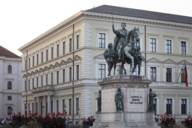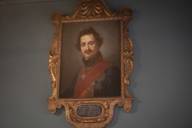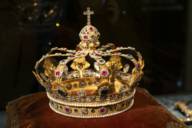
Of all Bavaria’s former Monarchs, it was Ludwig I and his architectural finesse that came to dominate Munich's cityscape above all others. His vision – to impress people both in Bavaria and beyond with numerous new buildings in the style of antiquity – blossomed magnificently.
Many people associate the state’s capital with the "Swan King", Ludwig II. But if we're being honest for a moment, such an association has less to do with his birthplace and more so with the seclusion offered by the Bavarian mountains where he commissioned work on numerous castles.
His grandfather, Ludwig I, was cut from a very different cloth: Even during his time as Bavarian Crown Prince, he drew up plans for buildings, churches, monuments and museums to fill his royal seat. And these testaments to another time continue to shape Munich to this very day. A trip to Italy in 1804 at the tender age of 18 sparked his enthusiasm, both for antiquity and the Italian Renaissance.
The buildings that line Ludwigstrasse are an enduring symbol of his love for Italy. By way of example, the Feldherrnhalle situated on Odeonsplatz is clearly recognisable as a copy of the Loggia dei Lanzi in Florence.
In 1830, Ludwig I opened the first public museum in Europe, the Glyptothek on Königsplatz. He procured a number of famous exhibits including the “Group of the Aegina” or the “Barberini Faun”, bringing these from Greece and Rome to Munich. The Antikensammlungen (antique collection) and the Propylaea rounded off the Greek ensemble – situated on Königsplatz – beautifully, earning Munich the nickname “Athens on the Isar".

The museums situated on Königsplatz, as well as the Pinakothek art galleries also built upon the commission of Ludwig I, went on to lay the corner stone for what is today’s museum landscape in the city’s Kunstareal (art quarter). Even the Bavaria and the Ruhmeshalle (hall of fame) situated above Theresienwiese were also created for his Regency. "I want to transform Munich into a city that honours Germany so whole-heartedly that no one may claim to know Germany until they have seen Munich!” That was the royal plan from which such a stunning visual delight came to be. By the end of his reign in the mid-19th century, Ludwig I had succeeded in ensuring that Munich could confidently match Paris as a city of art.
We also owe a debt of gratitude to the Monarch for two other iconic institutions: the city’s beer gardens and the Oktoberfest. A horse race that was organised in honour of Ludwig's wedding with Therese von Sachsen-Hildburghausen in 1810 ultimately went on to establish what has become the world’s largest folk festival, a global phenomenon 200+ years young. The venue "Theresienwiese" was named after his wife. From the year 1835 onwards, the Oktoberfest began marking the festival’s first weekend with a costume parade.

The move was also borne out of a certain political necessity, given that Ludwig I was now facing the difficult task of integrating new regions recently adjoined with Bavaria, such as Franconia and Swabia. The first costume parade in honour of the king's silver wedding anniversary was a spectacle involving all Bavarian subjects from every region, who adorned their own unique regional costumes to mark the occasion.
The birth of the typical Bavarian beer garden was the result of his royal permission that allowed beer to be served directly in the breweries, under the shade of large chestnut trees planted directly above the rock cellars. Even today, it is still permitted to eat the food you have brought with you as you enjoy a fresh Maß of beer drawn straight from the tap.
In 1848, the year of revolution, Ludwig I abdicated and gave way to his son Maximilian II. His premature abdication was attributed to the scandal surrounding his affair with the dancer Lola Montez and the fact that he failed to embrace the political zeitgeist – something clearly demonstrated by his resolute rejection of the nation’s growing transition to a constitutional monarchy. A "mere king in title only" was not something he was prepared to accept.